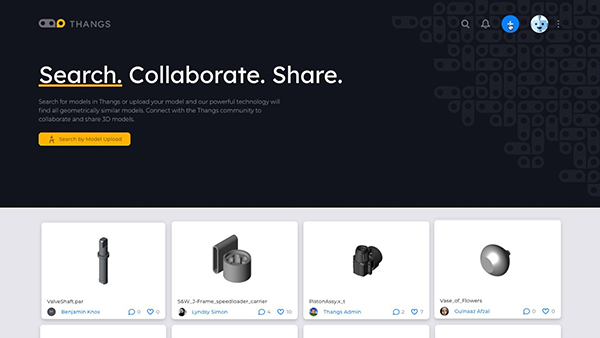Physna Enters the Shape-Search Engine Business
Company employs machine learning and algorithms to identify geometric matches for mechanical parts

Physna, which operates the Thangs content portal, hopes to become a geometric search engine for engineering and design software users. Image courtesy of Phsyna.
Latest News
November 16, 2020
Ohio-based startup Physna is the latest to throw its hat into the geometric search-engine business, targeting mechanical design software users. Founded in 2015, the company says its “geometric deep-learning technology bridges the gap between physical objects and digital code.”
At the heart of Physna's shape-matching system is what the company calls PNA (Physical DNA), a proprietary coding method that identifies and records a shape's geometric features (such as holes, faces, and alignments) and mathematical properties (the hole's radius, the distances between various faces, etc.).
Physna's technology can identify not just matching shapes but also where the object is used. This helps you identify, for example, not just a washer or a bracket from a certain supplier, but also assemblies where the same item is embedded.
Physna's public search portal is Thangs, launched this August. Thangs offers members the ability to upload, share, and collaborate on 3D models, similar to GrabCAD, an online 3D content site owned by Stratasys.
“Thangs' powerful geometric search engine allows users to find models with a wide range of search terms based on the object's physical properties, measurements and features. Thangs also identifies similarities and differences between 3D models, recognizes how parts fit within complex assemblies and makes accurate predictions about each object's function, cost, materials, performance, compliance and more,” Physna says in the announcement.
The Race to be the Google of Shape Search
Contenders such as Physna, iSeek Corp, and TraceParts are competing to be the preferred destination for mechanical software users and part suppliers. There's much to be gained from becoming the de facto geometric search portal for a specific discipline or industry segment. For a start, part suppliers will want to partner with such a site for better visibility of their offerings. CAD and PLM software vendors may also seek integrations to enable users to automatically generate bill of materials (BOM) and assembly documentations.
To improve shape identification and classification, many operators now turn to machine learning and algorithms. TraceParts recently partnered with Purdue University researchers to apply machine learning to develop an open-source annotated database of more than 58,000 3D mechanical parts.
“We are in the deep-learning era, using computers to search for things visually,” said Karthik Ramani, Purdue’s Donald W. Feddersen Distinguished Professor of Mechanical Engineering. “But no one is focusing on the parts that go into machines: pipes, bearings, motors, washers, nuts and bolts, etc. Those are the things that are important to us as engineers and manufacturers. We want to be able to point a camera at a real-world part, and have the computer tell us everything about that part or design.”
In September, Physna's Thangs portal reached 10,000 registered users. The site is now populated with more than 1,112,000 models, according to Physna. The company also plans to offer Physna Enterprise subscriptions for $2,500 per user, per year.
Subscribe to our FREE magazine, FREE email newsletters or both!
Latest News
About the Author
Kenneth Wong is Digital Engineering’s resident blogger and senior editor. Email him at [email protected] or share your thoughts on this article at digitaleng.news/facebook.
Follow DE





